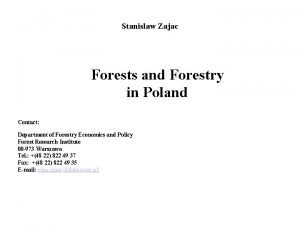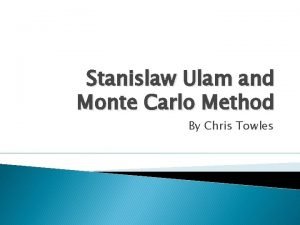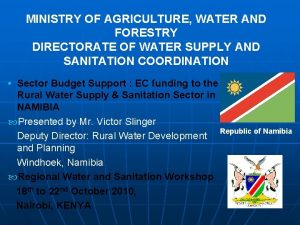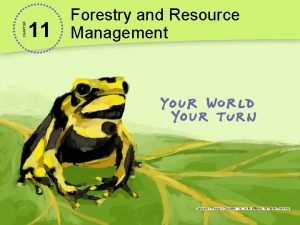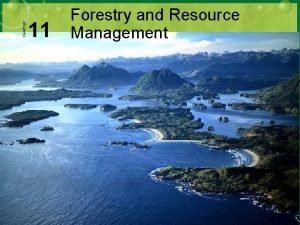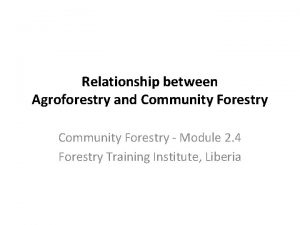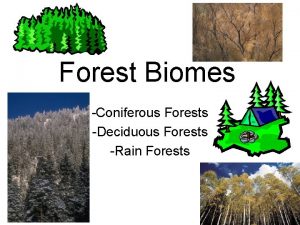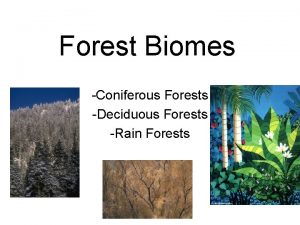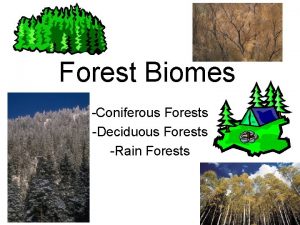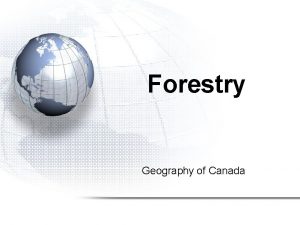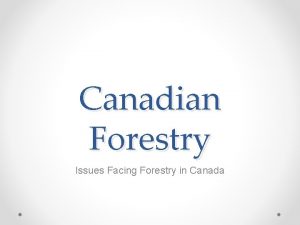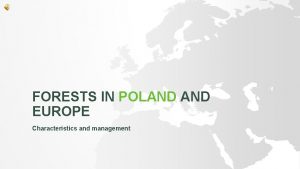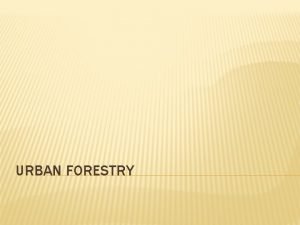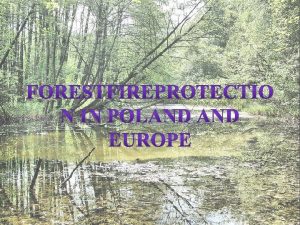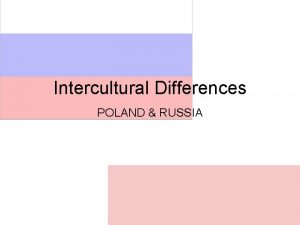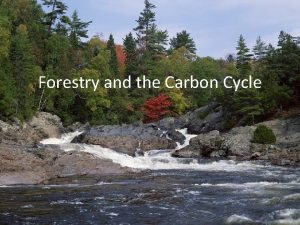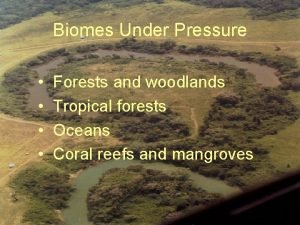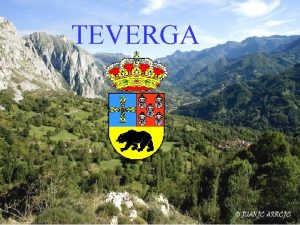Stanislaw Zajac Forests and Forestry in Poland Contact

























- Slides: 25

Stanislaw Zajac Forests and Forestry in Poland Contact: Department of Forestry Economics and Policy Forest Research Institute 00 -973 Warszawa Tel. : +(48 22) 822 49 37 Fax: +(48 22) 822 49 35 E-mail: stan. zajac@ibles. waw. pl

STRUCTURE OF THE PRESENTATION 1. INTRODUCTION 2. GENERAL INFORMATION 3. FOREST ADMINISTRATION 4. FOREST POLICY AND LEGISLATION 5. FOREST PROGRAMMES 6. FINANCING SYSTEM IN FORESTRY 7. FINAL REMARKS

POLISH FORESTS & FOREST RESEARCH INSTITUTE

GENERAL INFORMATION ON THE POLISH FORESTS AND FORESTRY FORESTS – 8 894 mill. ha – 28, 4% (21% in 1945) OWNERSHIP STRUCTURE Public – 7 349 thous. ha (82, 6%), within: State Forests – 6 968 thous. ha (78, 3%) national parks – 181 thous. ha (2, 0%) other – 200 thous. ha (2, 3%) Private – 1 545 thous. ha (17, 4%), within: private persons – 1 447 thous. ha (16, 3%) other – 98 thous. ha ( 1, 1%) STOCK VOLUME – 1 572 mill. m 3 (187 m 3/ha) State Forests – 1 380 mill. m 3 private forests – 151 mill. m 3 other – 41 mill. m 3 INCREMENT – 39 mill. m 3/year (5, 0 m 3/ha) HARVESTING: 26, 7 mill. m 3 (State For. 25, 1 mill. m 3) 1985 – 24, 1 mill. m 3 (21, 5 mill. m 3 ) 1991 – 18, 1 mill. m 3 (15, 5 mill. m 3) IMPORT – 0, 732 mill. m 3 of round wood (36, 2 mll. USD) EXPORT – 0, 349 mill. m 3 (85% pulpwood, 15% saw logs) NET INCOME (USD): + 34, 7 mill. (2000), – 20, 7 mill. (2001)

Structure of land use in Poland

Species composition in the State Forests in 2001 (share in stock volume)

Assortment’s structure of the removals in State Forests (harvesting volume of 25, 1 mill. m 3 in 2001) Specification Total Large wood*) Coniferous Sawlogs Veneer Pit-props Pulpwood Fuelwood Other Broadleaved sawlogs Veneer Pulpwood Fuelwood Small wood**) 1985 100 96 80 37 1 7 21 9 5 16 6 1 5 4 4 1990 [%] 100 94 74 39 1 5 18 6 5 20 6 1 8 5 6 1995 2000 100 92 68 34 0 4 22 3 5 24 8 1 11 4 8 100 94 68 28 0 3 31 4 2 26 7 1 14 3 6 *) above 5 cm u. b. at the top **) below 5 cm u. b at the top

Ownership structure of forests Public Private


Average size of private forest holdings Size of forest holding area (ha) 0, 1 - 0, 5 - 1, 0 - 2, 0 - 3, 0 - 5, 0 - 10, 0 - 15, 0 - 20, 0 > 20, 0 Total Area (ha) 77 143 156 712 219 790 173 865 199 465 178 055 58 048 25 516 49 437 (%) Number of forest holdings (thous. ) (%) 6, 8 13, 8 19, 4 15, 3 17, 5 15, 6 5, 1 2, 2 4, 3 312 216 154 73 53 27 5 2 2 37, 0 25, 6 18, 3 8, 6 6, 3 3, 2 0, 6 0, 2 1 138 31 100, 0 844 100, 0

Comparison of some features of private and state-owned forests Feature 1. Share of poor quality habitats (%) 2. Share of youngest stands (%) 3. Standing volume (m 3/ha) 4. Share of protective forests (%) Category of forest ownership private state 42, 1 31, 3 58, 4 36, 6 114, 0 196, 0 4, 4 48, 2

Economic importance of private and state-owned forests Feature 1. Share of forestry production per country (%) 2. Share of harvesting volume per country (%) 3. Share of fuelwood in harvested volume (%) 4. Share of large timber in harvested volume (%) Category of forest ownership private 14 7 18 60 state 86 93 6 45

State Forests assistance 1) preparing of periodic large-scale inventories, 2) maintenance of a databank concerning forest resources, 3) providing professional opinion on projects of simplified forest management plans, 4) covering costs of forest protection, 5) providing professional advice service on forest economy, 6) providing seedlings for the purpose of forest regeneration, 7) financial assistance to afforestations, from a special forest fund.

Tax system 1) revenues are not subject to income-tax, 2) forest tax relates only to over 40 -years-old stands, 2) the merest 7% VAT tax for raw timber. State budget subsidies 1) development of simplified forest management plans, 2) afforestation of the poorest agricultural land waste land, 3) maintenance of supervisory services in non-state-owned forests.

Forms of private forests supervision*)

F o r e s t T r a n s p o r t ( 3 ) ORGANIZATIONAL STRUCTURE OF THE STATE FORESTS DIRECTORATEGENERAL OF THE STATE FORESTS (Office 1) REGIONAL DIRECTORATE OF THE STATE FORESTS (Offices 17) DIRECTOR-GENERAL OF THE STATE FORESTS (1) DIRECTOR OF THE REGIONAL DIRECTORATE OF THE STATE FORESTS (17) SERVICE DEPARTMENTS (7) FOREST INSPECTORATES IN FOREST DISTRICTS (438) FORESTS RANGERS DEPARTMENTS OF NATIONWIDE RANGE

FOREST POLICY AND LEGISLATION National Policy on Forests (1997) · Act on Forests (1991) · Act on Protection of Nature (1991) · Act on Protection of Environment (2001) · Act on Protection of Arable and Forest Land (1995) · Land Development Law (1994) • Act on retention of the country’s character of the strategic natural resources (2001)

OBJECTIVES OF THE FOREST POLICY · Increase the part of forests in forming natural balance and life conditions · Reduction of destructive influence of the industrial civilization on the natural environment · Maintaining the persistence of forest ecosystems and the ecological continuity of forests areas (eco-development) · Preservation of genetic resources of plants and animals (bank of genes) · Enrichment of species composition and structure of the standing wood resources · Extension of the multi-sided utility of forests (protective, social, productive) · Enlargement the share of the forests and tree planting areas · Rationalized utilization of the wood raw material

REALIZATION OF THE FOREST POLICY OBJECTIVES · Approving the conception of eco-development · Performing the economical activity without involving damages in forests · Forming of multi-functional forest associations rich in the species composition and structure · Forming substitute nature communities on degradated areas · Afforestation of the grounds useless for agriculture · Elastic use of market mechanisms in forming supply and demand for material and non-material services of the forests · Exacting fully indemnities for damages caused by known authors · Defraying by the state budget the costs for redressing damages caused by unknown authors · Ensuring substantial and technical assistance for private forests · Forming and ecological consciousness of the society with regard to the part of forests and forestry in the economy and life of the country

Act on Forests … sustainable forest management is based on the forest management plan and focused on: 1) maintain forests and their beneficial influence on climate, air, water, soil, environment for people’s life and health and ecosystem /ecological balance/, 2) protect forests: variety of nature, preservation of forest genetic resources, landscape quality, scientific needs, 3) protection of soil, 4) protection of surface waters and underground waters, 5) production of wood, raw materials and non-timber products

FOREST PROGRAMMES · Parliament resolutions on sustainable development · Ecological Police of the State · Complex Forest Protection programme · Forest Act and its following amendments · Ordinances of Minister of Environment · Policy of Balanced Forest Economy · Regulations of General Director of State Forest Promotion Forest Areas National Programme of Forest Cover Increase National Forest Programme



Effects of afforestation of marginal agriculture lands • establishing new work places • additional income source for agriculture land owners • decrease of greenhouse effect (carbon sequestration) • water balance improv. , water protection, counteracting • water and wind erosion • increasing biological diversity on agriculture areas • Improving tourist attractiveness of agriculture areas

DRAFT SCHEME OF THE FINANCIAL SYSTEM OF THE STATE FORESTS Incomes from basic activity Incomes from side activity Incomes from administrative activity INCOMES Event. surcharges from forest fund St a t e b u d ge t Purposeful subsi-dies for: repurcha-se of forests, recul-tivation and afforestation of grounds, cultivation and protection of threated forests, maintaining of nature preserves etc. Incomes from grounds and forests sale SUBSIDIES Remittance of incomes from grounds and forests sale Costs of subsidiesed and entrusted works Costs of administrative and basic activity Taxes Deduction on maintenance of superior units and forests management EXPENSES Compulsory deduction under General Directorate decision Investments Forest fund Costs of side and additional activity Deduction on purposeful funds Deduction on forests fund and extraordinary reserves G D S F Incomes from additional activity SURPLUS /+/ of incomes over expenses, within from side activity, addititional activity, basic and administrative activity or LOSS /-/ Purposeful funds Forest district investments
 Stanislaw zajac
Stanislaw zajac Zakrslý zajac
Zakrslý zajac Minister zdravotníctva zajac
Minister zdravotníctva zajac Príslovky
Príslovky Ken zajac
Ken zajac Ulam monte carlo
Ulam monte carlo Stanislaw ulan
Stanislaw ulan Testemunha tranquila atividades
Testemunha tranquila atividades Jlich
Jlich Examples of non contact force
Examples of non contact force Which of the following is sliding contact bearing
Which of the following is sliding contact bearing Post encounter stage
Post encounter stage Contact and noncontact forces
Contact and noncontact forces Contact and non contact forces
Contact and non contact forces What is a contact force
What is a contact force Is tension force contact or noncontact
Is tension force contact or noncontact Irritant contact dermatitis vs allergic contact dermatitis
Irritant contact dermatitis vs allergic contact dermatitis Is gravity a noncontact force
Is gravity a noncontact force Dangling bond in fullerene
Dangling bond in fullerene Ministry of agriculture, water and forestry directorates
Ministry of agriculture, water and forestry directorates Chapter 11 forestry and resource management
Chapter 11 forestry and resource management Forestry and resource management chapter 11 answers
Forestry and resource management chapter 11 answers Mendel university of agriculture and forestry
Mendel university of agriculture and forestry State and private forestry
State and private forestry Difference between agroforestry and community forestry
Difference between agroforestry and community forestry Maine department of agriculture conservation and forestry
Maine department of agriculture conservation and forestry
